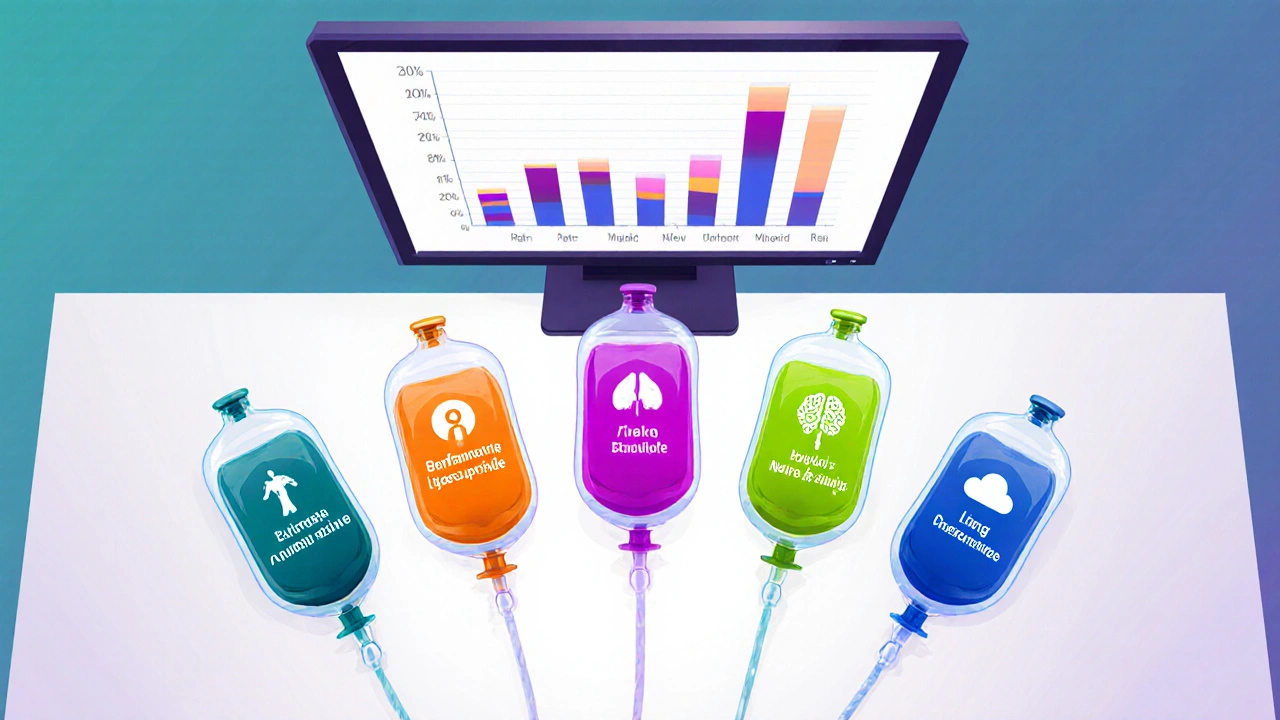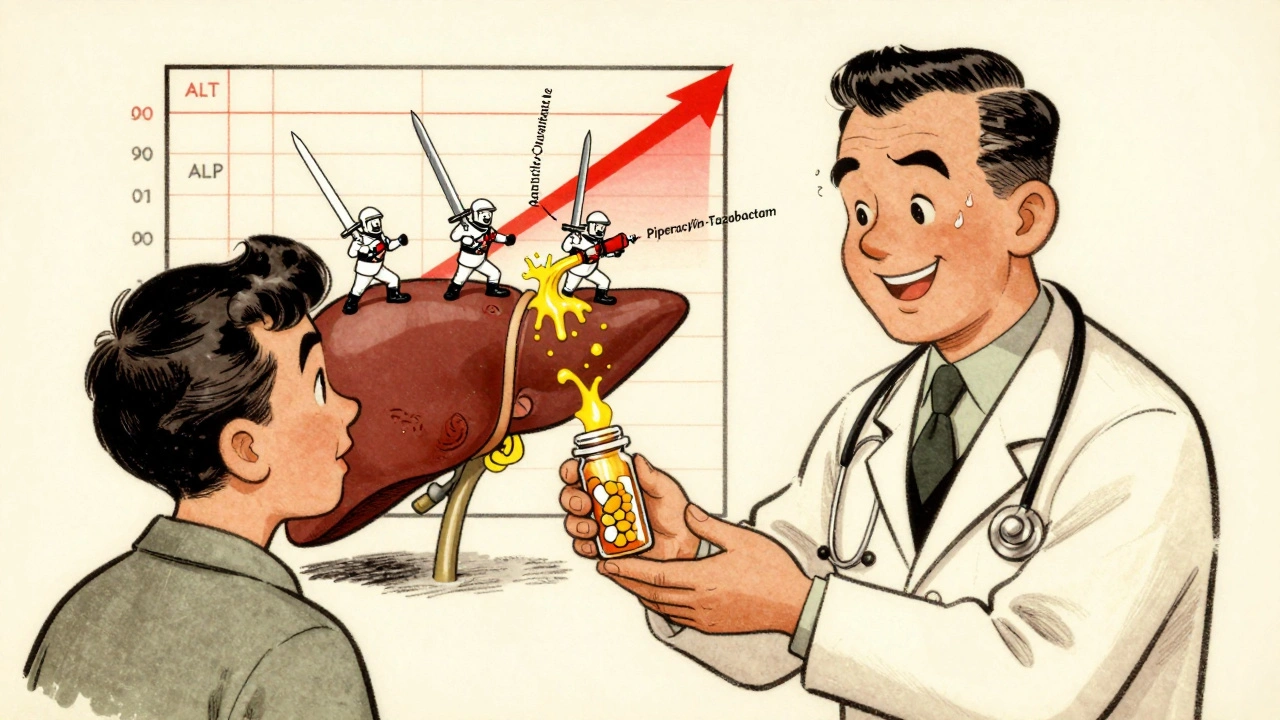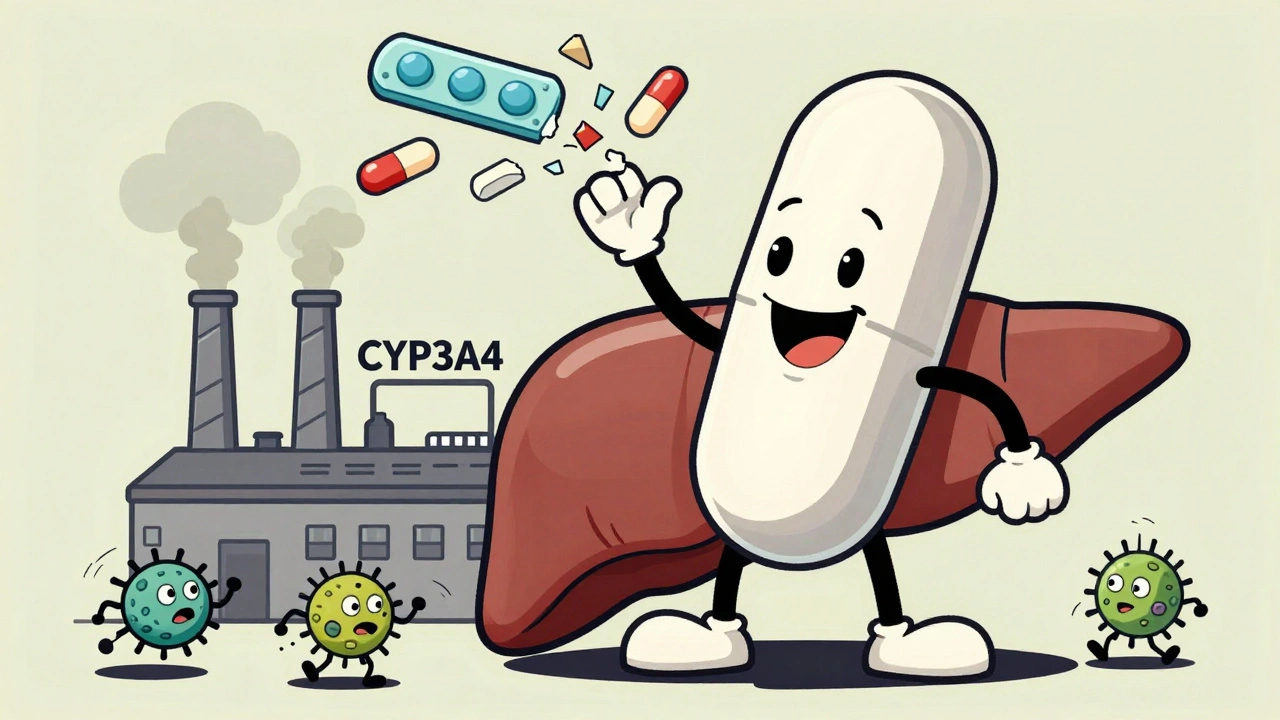Alkeran (Melphalan) vs Other Alkylating Agents Comparison Tool
| Drug | Primary Indications | Typical Dose | Key Advantage | Major Toxicities |
|---|
When faced with a cancer diagnosis, the choice of chemotherapy can feel like navigating a maze. Alkeran (melphalan) is a well‑known alkylating agent, but it isn’t the only option on the table. This guide breaks down how Alkeran stacks up against its most common rivals-bendamustine, ifosfamide, cyclophosphamide, and busulfan-so you can see which drug fits the specific cancer type, treatment goals, and side‑effect tolerance.
TL;DR - Quick Takeaways
- Alkeran is excellent for multiple myeloma and ovarian cancer but has strong bone‑marrow suppression.
- Bendamustine combines alkylating and antimetabolite actions, offering better tolerance for older patients.
- Ifosfamide works best for soft‑tissue sarcoma and germ‑cell tumors; watch for neurotoxicity.
- Cyclophosphamide is a versatile workhorse used in breast, lymphoma, and autoimmune diseases.
- Busulfan is a high‑dose option for stem‑cell transplant conditioning; requires careful monitoring.
What Is Alkeran (Melphalan)?
Alkeran is a nitrogen mustard alkylating agent whose generic name is melphalan. It creates cross‑links in DNA strands, preventing cancer cells from replicating and ultimately triggering cell death. First approved in the 1960s, Alkeran is primarily used for multiple myeloma and ovarian cancer, though it also sees occasional use in certain head‑and‑neck and neuroblastoma protocols.
How Does Alkeran Work?
The drug’s mechanism relies on adding alkyl groups to the N7 position of guanine bases. This causes intra‑ and inter‑strand DNA cross‑links, which block transcription and replication. Because rapidly dividing tumor cells cannot repair this damage efficiently, they undergo apoptosis. Unfortunately, the same DNA‑damage pathway also hits normal bone‑marrow cells, leading to the hallmark side effects of neutropenia and anemia.
Key Alternatives to Alkeran
Below are the four most frequently considered alternatives, each with its own niche.
Bendamustine is a hybrid alkylating‑antimetabolite that interferes with DNA synthesis and repair.
Approved for chronic lymphocytic leukemia (CLL) and indolent non‑Hodgkin lymphomas, bendamustine tends to cause less severe myelosuppression than melphalan. Its dual action can be useful when tumors develop resistance to classic alkylators.
Ifosfamide is a cyclophosphamide analogue that requires activation by hepatic enzymes.
Ifosfamide shines in soft‑tissue sarcomas, testicular cancer, and certain brain tumors. The drug produces acrolein, a metabolite that can irritate the bladder; prophylactic mesna is standard to prevent hemorrhagic cystitis.
Cyclophosphamide is a widely used alkylating agent that also relies on hepatic activation.
Its versatility makes it a backbone in breast cancer, Hodgkin lymphoma, and autoimmune regimens (e.g., lupus nephritis). Compared with melphalan, cyclophosphamide often allows outpatient dosing and has a broader safety window.
Busulfan is a bifunctional alkylating agent primarily used in bone‑marrow transplant conditioning.
Busulfan’s high myeloablative power makes it a go‑to for preparing patients for stem‑cell transplant. However, its narrow therapeutic index demands therapeutic drug monitoring to avoid seizures and pulmonary fibrosis.

Side‑Effect Profiles - What to Expect
All alkylating agents share some common toxicities, but the severity and additional risks differ.
- Nausea is almost universal across IV chemotherapy and is mitigated with 5‑HT3 antagonists.
- Myelosuppression varies from mild (cyclophosphamide) to profound (melphalan, busulfan).
- Renal toxicity is a concern with high‑dose ifosfamide; dose adjustments are needed for impaired kidneys.
- Neurotoxicity, especially seizures, can occur with high‑dose busulfan; prophylactic anticonvulsants are recommended.
- Bladder irritation is specific to ifosfamide and cyclophosphamide due to acrolein; mesna and hydration are standard safeguards.
Direct Comparison Table
| Drug | Primary Indications | Typical Dose (mg/m²) | Key Advantage | Major Toxicities |
|---|---|---|---|---|
| Melphalan | Multiple myeloma, ovarian cancer | 0.25‑0.5 IV daily × 4days (high‑dose: 140‑200mg/m²) | High response rates in plasma‑cell disease | Severe myelosuppression, mucositis |
| Bendamustine | CLL, indolent NHL | 120mg/m² IV days1&2 q28d | Lower neutropenia, useful in elderly | Rash, fatigue, modest myelosuppression |
| Ifosfamide | Sarcoma, testicular cancer | 1.5‑2g/m² IV days1‑5 | Effective against soft‑tissue sarcoma | Hemorrhagic cystitis, neurotoxicity |
| Cyclophosphamide | Breast cancer, Hodgkin lymphoma, autoimmune | 600‑1000mg/m² IV q21‑28d | Versatile, outpatient dosing | Bladder toxicity, moderate myelosuppression |
| Busulfan | Stem‑cell transplant conditioning | 0.8‑1.0mg/kg IV q6h × 4days (or oral) | High myeloablative power | Seizures, pulmonary fibrosis, severe myelosuppression |
Decision Criteria - How to Choose the Right Agent
Picking a chemotherapy drug isn’t a flip‑of‑a‑coin. Consider these practical lenses:
- Cancer type and stage. Some agents have FDA‑approved indications that align perfectly with your disease (e.g., melphalan for refractory multiple myeloma).
- Patient age and comorbidities. Elderly patients often tolerate bendamustine better than high‑dose melphalan.
- Desired intensity. If you’re prepping for a stem‑cell transplant, busulfan’s myeloablation is unmatched.
- Side‑effect profile. For patients at risk of renal impairment, avoid high‑dose ifosfamide; for those prone to bladder issues, cyclophosphamide without mesna is risky.
- Logistics. Outpatient feasibility, need for therapeutic drug monitoring, and insurance coverage can tip the balance.
In practice, oncologists often blend agents-using low‑dose cyclophosphamide with melphalan, for instance-to get a synergistic effect while minimizing toxicity.
Practical Considerations: Administration, Monitoring, and Cost
All the drugs listed are given intravenously, except busulfan, which has an oral formulation for certain protocols. Here’s what clinicians and patients should watch for:
- Pre‑infusion labs. CBC, renal and liver panels are mandatory before each cycle.
- Therapeutic drug monitoring. Busulfan and high‑dose melphalan require plasma level checks to stay within target ranges.
- Supportive meds. Antiemetics (ondansetron, dexamethasone), growth‑factor support (filgrastim) for neutropenia, and mesna for ifosfamide/cyclophosphamide.
- Cost outlook (2025 UK NHS pricing). Generic cyclophosphamide is the cheapest (~£30 per cycle), while melphalan and bendamustine sit around £800‑£1,200 per treatment course. Busulfan, especially with monitoring, can exceed £2,500.
Insurance approvals often hinge on documented failure of first‑line therapy, so having a clear record of prior response to melphalan can open doors for alternative agents.
Frequently Asked Questions
Is melphalan the best first‑line drug for multiple myeloma?
Melphalan remains a cornerstone for high‑dose therapy before autologous stem‑cell transplant, but newer agents like bortezomib and lenalidomide are now standard frontline options. Melphalan is usually reserved for transplant‑eligible patients or those who have relapsed after modern regimens.
Can bendamustine replace melphalan in ovarian cancer?
Bendamustine isn’t approved for ovarian cancer and lacks robust data in that setting. It may be used off‑label in heavily pre‑treated cases, but cyclophosphamide‑based regimens remain the usual alternative.
What monitoring is needed for busulfan?
Therapeutic drug monitoring is essential. Blood samples are drawn after the first dose to calculate the area under the curve (AUC). Doses are then adjusted to keep the AUC within 900‑1500µM·min, reducing seizure and lung toxicity risk.
Why is mesna given with ifosfamide?
Ifosfamide metabolizes into acrolein, which irritates the bladder lining. Mesna chemically binds acrolein, preventing hemorrhagic cystitis. Standard practice is 60% of the ifosfamide dose given intravenously and orally at 0, 4, and 8hours post‑infusion.
How do side‑effects differ between melphalan and cyclophosphamide?
Both cause myelosuppression, but melphalan’s effect is typically deeper, leading to longer neutropenia. Cyclophosphamide adds bladder toxicity, which melphalan lacks. Nausea is comparable, though modern anti‑emetics make it manageable for both.
Choosing between Alkeran and its alternatives hinges on the cancer type, patient health, and how aggressively you can manage side effects. By weighing efficacy against toxicity, you can land on a regimen that maximizes chances of remission while keeping quality of life in check.






Suraj Midya
October 3, 2025 AT 04:34It is our duty to choose treatments that honor the patient’s dignity, even if the data sometimes feels muddled. Yet many rush into high‑dose melphalan without considering the moral weight of severe myelosuppression.
ashish ghone
October 3, 2025 AT 22:37Reading through the comparison tool feels like opening a treasure chest of knowledge, and I’m grateful for the effort put into compiling such thorough details 😊. First, the clear breakdown of each drug’s primary indications immediately helps clinicians match therapy to disease, which is crucial for patient outcomes. The dosing tables are spot‑on, showing both standard and high‑dose regimens, and the inclusion of typical side‑effects lets us anticipate supportive care needs. I also appreciate the practical notes on administration, like the reminder that busulfan requires therapeutic drug monitoring to avoid seizures; that tiny detail can make a huge difference in a transplant setting. The section on side‑effect profiles does a great job differentiating which agents are more marrow‑suppressive versus those with bladder toxicity, helping us tailor prophylaxis such as mesna for ifosfamide. The decision‑criteria checklist is a nice touch, especially the emphasis on patient age and comorbidities, because older patients often cannot tolerate the intense myelosuppression seen with melphalan. Moreover, the cost outlook gives a realistic sense of budgeting, highlighting how cyclophosphamide remains the most affordable while busulfan can be quite pricey. The FAQs at the end address common uncertainties, like the role of melphalan in modern myeloma therapy, which is especially helpful for trainees. Overall, this guide balances scientific rigor with user‑friendly language, making it accessible to both oncologists and patients seeking to understand their options. Keep up the fantastic work, and maybe consider adding a quick‑reference chart for rapid bedside decision‑making in future updates! 🙌 Additionally, the interactive filter for cancer type and age group could be transformed into a mobile app, which would allow clinicians to access the data on rounds without a laptop. The inclusion of high‑dose regimens for melphalan reminds us of the importance of stem‑cell support and the logistics of cryopreservation. It would also be useful to see a brief discussion on emerging agents that may replace some of these older alkylators in the next decade. Finally, acknowledging patient‑reported outcomes alongside clinical toxicity would round out the picture and place the patient’s voice front and center. I encourage you to keep updating the tool as new trial data emerge, ensuring it remains a living resource for the oncology community.
steph carr
October 4, 2025 AT 16:41Great job summarizing the nuances of each alkylating agent – this kind of clear, concise information really empowers patients and healthcare providers alike.
Vera Barnwell
October 5, 2025 AT 10:44Oh, the tangled web of chemotherapy choices! One can almost hear the whispers of old‑school oncologists insisting that melphalan is the only true weapon, while the hidden forces of pharmaceutical lobbying push newer “magic bullets” that may or may not exist. The data presented here feels like a map through a labyrinth, yet every corner hides a potential pitfall – from the dreaded seizures of busulfan to the silent, insidious marrow collapse caused by high‑dose melphalan. I can’t help but wonder why we’re still dancing with these toxic giants when the secret labs are supposedly developing gentler, targeted alkylators that remain under wraps. Still, the author did a decent job of laying out the side‑effects, but the underlying conspiracy of profit over patient safety never truly disappears. In any case, kudos for the thoroughness, even if the world of chemo feels like a theater of shadows.
Dawn Midnight
October 6, 2025 AT 04:47The table provides a clear comparison of the agents, but there are a few grammatical errors that need correction. For instance, “severe myelosuppression” should not be capitalized in the middle of a sentence. Additionally, ensure consistent use of the Oxford comma throughout the list of toxicities.
frank hofman
October 6, 2025 AT 22:51Sure, but aren’t we just glorifying chemo when there are better alternatives?
Dannii Willis
October 7, 2025 AT 16:54I appreciate the comprehensive nature of this guide; however, it would be helpful to include references to the latest clinical trials for each agent to validate the statements made.
Robyn Du Plooy
October 8, 2025 AT 10:57The pharmacodynamic interplay you described underscores the importance of DNA cross‑linking kinetics and the subsequent activation of the ATR‑CHK1 pathway, which ultimately dictates cellular apoptosis versus repair mechanisms. Incorporating such mechanistic insights could elevate the tool from a clinical summary to a translational resource.
ayan majumdar
October 9, 2025 AT 05:01nice tool but could use a simpler layout
Johnpaul Chukwuebuka
October 9, 2025 AT 23:04Wow! This guide makes it so easy to see which drug fits which patient – keep pushing the boundaries and helping people understand their treatment options!
Xavier Hernandez
October 10, 2025 AT 17:07Choosing a drug with reckless abandon is a betrayal of the sacred trust between doctor and patient; we must uphold the highest ethical standards when prescribing such potent agents.
Zach Yeager
October 11, 2025 AT 11:11Obviously the best choice is the one that aligns with our national guidelines, no need to overcomplicate the discussion.
Phoebe Chico
October 12, 2025 AT 05:14When we dissect the philosophical underpinnings of medical decision‑making, we realize that adherence to guidelines is but one facet of a broader existential pursuit of patient autonomy and dignity.
Michael Stevens
October 12, 2025 AT 23:17The clarity of this comparison will undoubtedly aid clinicians in making more informed choices, and I’m sure patients will benefit from the increased transparency.
Ann Campanella
October 13, 2025 AT 17:21It's decent but could use more depth.
Desiree Tan
October 14, 2025 AT 11:24Let’s keep championing patient‑centered care and push for even more detailed toxicity management strategies in future updates!
Rakesh Manchanda
October 15, 2025 AT 05:27While the data is competently presented, one cannot help but notice the absence of a nuanced discussion on the molecular heterogeneity that dictates differential response to alkylating agents.
Erwin-Johannes Huber
October 15, 2025 AT 23:31Indeed, incorporating molecular profiling into the decision matrix would provide a more personalized approach, enhancing therapeutic efficacy.
Tim Moore
October 16, 2025 AT 17:34I commend the authors for delivering a meticulously structured comparison; such scholarly work significantly contributes to the body of oncologic literature.